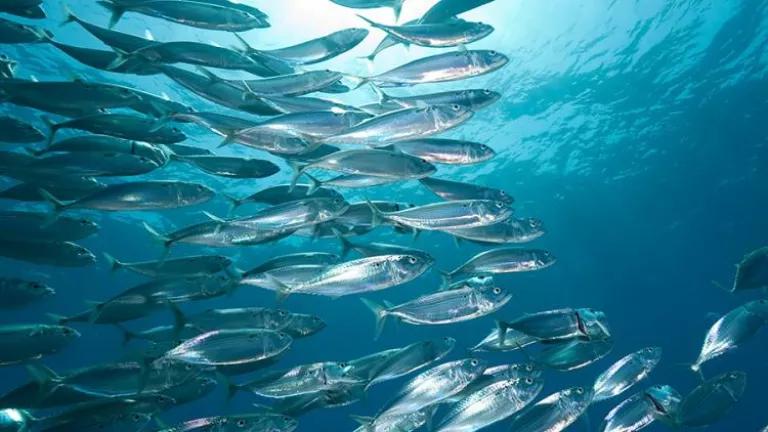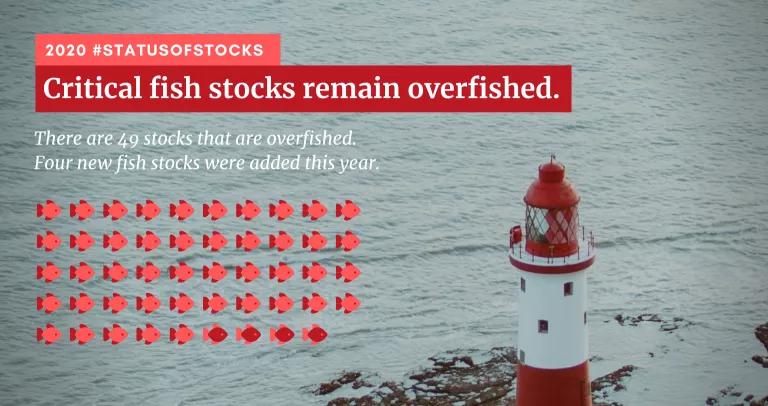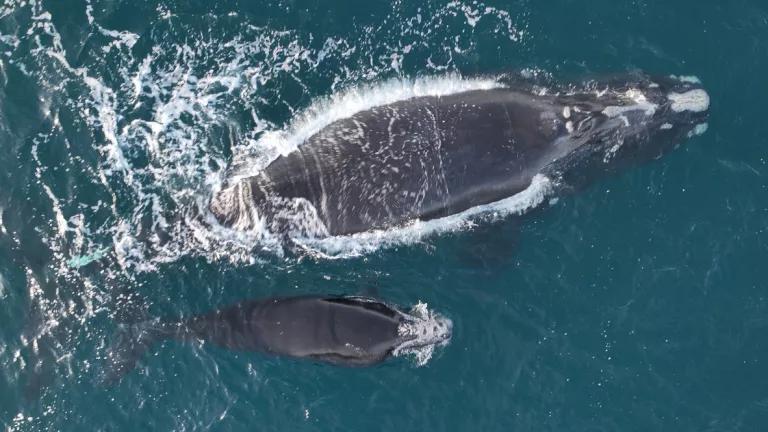What Is the Status of U.S. Fisheries?
New Status of Stocks report shows we must act now for healthy and resilient fisheries

Atlantic mackerel, an important forage species.
New Status of Stocks report shows we must act now for healthy and resilient fisheries
This National Ocean Month, as we take time to appreciate the “big blue,” we must not forget to thank its unsung—and gilled—heroes. When we picture a healthy ocean, most of us see one teeming with fish. Healthy fish populations are building blocks of marine ecosystems, affecting everything else in the food web from whales to seabirds. They are also engines of our coastal economies and the communities that rely on them, with fisheries in the United States supporting an estimated 1.7 million jobs.
But a new report from NOAA Fisheries, the 2020 Status of Stocks report, shows some concerning trends for the health of U.S. fisheries.
Looking at 460 federally managed fish stocks and stock complexes, the report shows a recent increase in the number of overfished stocks. Meanwhile, no stocks have been rebuilt to healthy levels in the previous year, and eight stocks have become overfished once again after previously successful rebuilding.
There is a lot to unpack here, but one main takeaway is this: despite historic successes in sustainable fisheries management, we have a lot of work to do to prevent backsliding of fisheries conservation. This job is made all the more important due to climate change, as fish populations off our coasts are moving into cooler waters, decreasing in productivity, and facing more frequent extreme events such as marine heat waves.
The federal law that guides management of our ocean fisheries, the Magnuson-Stevens Act, has shown us that that putting long-term fisheries sustainability first—and sticking with it—can work. With science-based requirements to end overfishing and rebuild overfished populations, we have successfully rebuilt 47 fish stocks and significantly curbed overfishing in U.S. fisheries.
While this progress is to be lauded, the job is far from complete. A number of fish stocks have struggled to recover, and several stocks remain subject to unsustainable fishing rates and risky management decisions. The trends in the latest Status of Stocks report bear this out:

- 49 fish stocks (20% of all known fish stocks) are overfished, meaning their population levels are too low and their ability to support sustainable fishing is jeopardized. This includes iconic stocks like Atlantic cod in New England that are still struggling to recover from historical, chronic overfishing. 20% (as a percentage of stocks with known overfished status) is the largest percentage of overfished stocks since 2012. It is also part of a three-year trend of more stocks becoming overfished.
- Four fish stocks were added to the overfished list in 2020. One of the now 49 stocks declared overfished is Atlantic herring, a critically important forage species relied on by sea birds and marine mammals for food. Fishery managers in New England recently voted to better manage Atlantic herring to account for its role in the ecosystem, but before this, years of poor recruitment and risky management decisions left the stock in a dire state. Under the Magnuson-Stevens Act, rebuilding measures will now be required to restore the fishery.
- Rebuilding progress has slowed. 47 stocks have been declared rebuilt since 2000, but that number is stalling out. Only three stocks have been rebuilt since 2017, and none have rebuilt in the last year. Several other important forage species remain on the overfished list, including Atlantic mackerel and Pacific sardine, as do several sharks and other highly migratory species.
- Eight of 47 stocks once declared rebuilt have since become overfished, again. One of these recurrent overfished stocks is bluefish, an important recreational species for anglers, which was successfully rebuilt in 2009, but ten years later reached another overfished state. Unfortunately, fishery managers in the Mid-Atlantic region just recently voted to select a longer, more risk-prone rebuilding plan for bluefish that allows greater harvest levels than other alternatives considered.
- Overfishing continues despite legal requirements to prevent it. While overfishing, or fishing at an unsustainable harvest rate, is near all-time lows, it still affects 8% of stocks with known overfishing status. Catch overages in some regions, such as the Gulf of Mexico and South Atlantic, have resulted in new additions to the overfishing list.

Of course, each fishery and each region has its own long history behind the numbers. But any way you slice it, these trends are not encouraging regarding the long-term sustainability of our fisheries. Successful fisheries management in the face of climate change will require a renewed focus on sustainable catch levels and strong rebuilding measures.
This is a critical window for Congress and the Biden Administration to act to secure the future of our fisheries.
One silver lining is a draft bill to reauthorize the Magnuson-Stevens Act, released last year by Representatives Jared Huffman (D-CA-2) and Ed Case (D-HI-1). As we covered in a prior blog, the bill seeks to build on the Magnuson Act’s successes and address remaining challenges, such as by: closing loopholes to put an end to chronic overfishing and help rebuilding plans stay on track; advancing climate-ready fisheries management tools and science; strengthening protections for important fish habitats, forage fish, and other marine species; and modernizing fisheries data collection and research. We look forward to the introduction of this bill in the 117th Congress.
The Biden Administration also has a key role to play in promoting healthier and climate resilient fisheries. NOAA Fisheries is an important check on prioritizing long-term sustainability in the fishery council decision making process. NOAA Fisheries also kickstarted a process this spring to collect broad public input on how to make our fisheries more resilient in the face of climate change—a critical dialogue which can and should be translated into fisheries management decisions. Stay tuned for more on this in the coming months.




